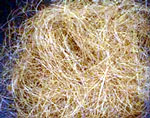|
|

The scientists at the National Institute for
Interdisciplinary Sciences and Technology (NIIST) have developed anenvironment-
friendly and pollution-free technology to separate coir fibre.
|
.. |
|
Technology to separate coir fibre developed
Reema Narendran
THIRUVANANTHAPURAM, January 06, 2009: In what could be termed as a blessing to the
ailing coir sector of the state, the scientists at the National Institute for
Interdisciplinary Sciences and Technology (NIIST) have developed an environment-friendly and pollution-free technology to separate coir fibre.
The innovative technology, that has many advantages over the traditional
retting methods, is awaiting an international patent. ``While all the current
alternatives to coir retting affects the quality of the fibre and thus its
spinnability, the new technology generates high-quality white fibre in a very
short time,’’ said V.B.Manilal, scientist at the environment technology division
of NIIST. The other scientists in the team include Ajit Haridas and B.Krishnakumar.
The pilot plant set up at the NIIST has a cleaner, a crusher, where the husks
are given a slight mechanical crush, and an anaerobic reactor. Inside the reactor, the cementing materials between the fibres are degraded. The phenolic
compounds in the husk, which are the sources of pollution in traditional retting, is converted to volatile fatty acids such as acetic acid. This is then
converted to methane by a battery of bacteria.
The novel bioprocess needs just about one month, as against the 6-12 months in
traditional methods, and is free of pollution as the pollutants are converted to
biogas. As much as 50 litres of biogas is generated for one kilogram of coconut
husks, the production being much higher than using cow dung.
``The smooth surface property, as can be seen with the electron microscope, and
the improved flexibility are the special qualities of these bioextracted
fibres. This quality is essential for high-end applications in the international
market,’’ said Manilal. The bioextraction process is also applicable for
separating fibres of pineapple, jute and even banana too, where the extraction
time is much less. The jute fibre obtained by this clean method is better in
terms of colour and bark residues too. In this method, the whole process is carried out within plantations and no water body is required for retting. This
means that water bodies can be released for a number of other uses such as fisheries and tourism industry can heave a sigh of relief. The other advantages
include zero discharge, no hazardous labour, no air pollution, reduction of process period to 30 days, and a clean pith as a by-product.
Using this technology, the projected figure of white fibre production per year
is 1.2 lakh tonne from 15 lakh tonne husks. Once this technology gains currency,
you won’t have to clutch your nose anymore when you travel by the coastal areas of Kollam and Alappuzha.
Source: Reema Narendran : India Express Buzz |
|

